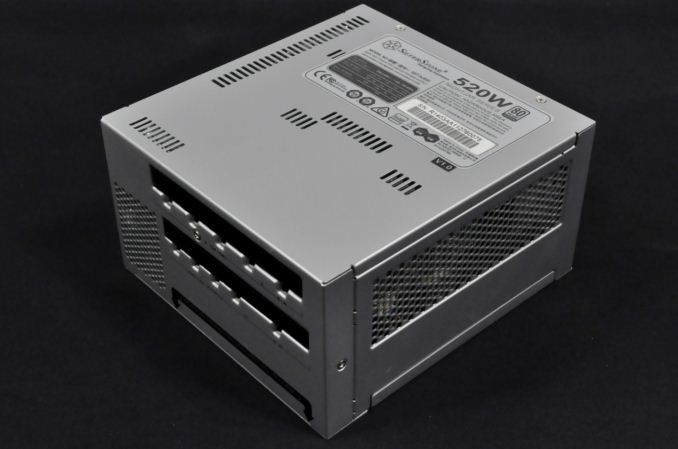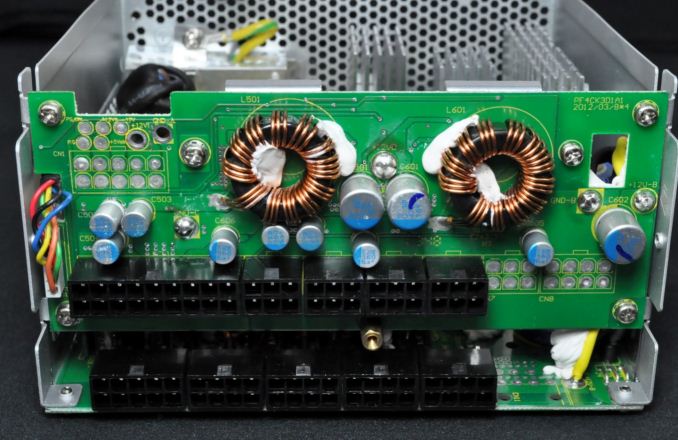SilverStone NightJar NJ520 Power Supply Review
by E. Fylladitakis on July 8, 2014 6:00 AM EST- Posted in
- Cases/Cooling/PSUs
- Seasonic
- PSUs
- Fanless
- SilverStone
Conclusion
Even though fanless computer PSUs are not a new concept, SilverStone's (or to be exact, Seasonic's) latest design is a refreshing approach. By greatly improving the energy conversion efficiency, there is no longer any need for bulky and expensive cooling solutions or even for exotic designs. The Nightjar NJ520 is very similar to any typical ATX-compliant PSU, with the exception of the "missing" cooling fan. Certain components and the heatsinks are oversized for a 520 Watt model, plus there are more ventilation openings, but that's where the major differences with a typical PSU end. It is very likely that the same exact platform will be found retrofitted with an active cooling system and minor other tweaks, selling as a 700-850 Watt unit, as the design can easily handle such output with the addition of active cooling.
When it comes to performance however, the Nightjar NJ520 is astounding. Seasonic's designs have always been well above average, but the electrical performance Nightjar NJ520 is nothing short of fantastic. This may be due to the oversized circuitry and components, which are usually found in units of higher output, allowing the Nightjar NJ520 to combine exceptional energy conversion efficiency and power output quality. The result is very high efficiency, which is not easily affected by temperature, and very low voltage ripple, from a power supply that generates zero noise as well.
Aside from its excellent performance, quality is another very strong characteristic of the Nightjar NJ520. Silverstone's choice of components has been excellent, as we failed to find even a single average-quality part inside the Nightjar NJ520. All of the capacitors, electrolytic and polymer alike come from highly reputable Japanese manufacturers, and the quality of the assembly and the soldering job are excellent as well, making the Nightjar NJ520 a truly well-made product. Warranty information regarding the Nightjar NJ520 is a bit hazy, as the length of the warranty is not specified on the box or even in the manufacturer's website; however, Silverstone covers the vast majority of their products with a three year limited warranty, and we believe that it includes the NJ520 even though the model is not specifically listed at the time of this review.
The high quality and oversized design however also are the source of this unit's major weakness. Since the Nightjar NJ520 is significantly oversized and essentially comprised of parts normally meant for more powerful units, it also is equally overpriced for a 520 Watt power supply. With a retail price of $139.99 including shipping (after rebate), the price tag of the fanless Nightjar NJ520 is almost equal to that of 750 Watt 80 Plus Platinum PSUs (which of course include a fan for active cooling). Overall, the Nightjar NJ520 is a very high quality fanless modular PSU with excellent electrical performance; whether the fanless design is worthy of such a premium price however heavily depends on the budget and priorities of the user. If your priority is noiseless operation combined with great overall performance and quality and you are willing to pay the rather steep price to get what you want, the Nightjar NJ520 will not be a disappointment.












44 Comments
View All Comments
houkoholic - Wednesday, July 9, 2014 - link
The usual good silent case with the right padding are also big. My last two silent cases were the famed Antec P180/182. Sure they were silent but they were nearly full tower size huge, I simply have no need for so much space in my current lifestyle when all I need in my build that isn't already on the motherboard is nothing more than a SSD, a single data storage HDD and one GPU.Recently I build a small micro-ITX build using the Antec ISK600 case, the shell of that case is just thin aluminium with no sound proofing unlike the P180s. So I put in a fanless PSU in there, threw out the Intel cooler for a Noctua tower cooler which runs a 120mm fan, the included case fan was good enough to be near silent thus my only component which makes any sort of whirling noise now is the the GPU stock cooler. In the end my build is silent and its footprint is small enough that I can put it on a bookshelf right next to my ears yet it is powerful enough for gaming. My total fan count in the build is 3 instead of 4, and one less fan is still one less component to worry about contributing to noise.
houkoholic - Wednesday, July 9, 2014 - link
One less part contributing to the noise can still factor in. Any fan could be victum to dust and wear which causes it to start making noise (happened to me a few times with PSU). If I have to pay for the privelage such that I don't have to clean my PSU fan as well, so be it, and that already has a point for its existence - and I suspect that there are enough people out there thinking the same to justify the existence of such products.dishayu - Wednesday, July 9, 2014 - link
This will go really well with my reference design R9 290. :Dsheh - Wednesday, July 9, 2014 - link
Thanks for the review!A request: Can you start testing PSUs at specific load (or draw) wattages instead of percentages, and go lower than 50W? Percentages arne't very meaningful by themselves, and watts can be compared directly. And watt-wise, modern computers under light load take less than 50W. Much less, actually. So 20% of this PSU might be what a modern computer draws at maximum CPU load.
mapesdhs - Wednesday, July 9, 2014 - link
I agree, I think my gateway uses about 30W or so.
Ian.
E.Fyll - Wednesday, July 9, 2014 - link
Actually no, because that is beyond the testing guidelines. 20% is the minimum acceptable testing limit for switching PSU power quality tests. It would also be meaningless to test a 1000 Watt unit at 50 Watt; that only implies that this unit should not have been there in the first place.Switching PSUs are inherently not capable of efficient operation at very low loads. It is worse to have a far too powerful PSU rather than a heavily loaded PSU.
torp - Thursday, July 10, 2014 - link
Testing guidelines be damned. A modern desktop idles at 40 W or less. I don't care what the specifications say, I want to know the efficiency in real world conditions. It's not like you can buy sub 500 W PSUs any more... with the lone exception of Seasonic's G360... if still available.sheh - Thursday, July 10, 2014 - link
400-450W are rather common, and maybe some <400W as well. But I think what's more pertinent is that span of loads in modern computers is larger than it used to be. CPUs and graphics cards have better dynamic power management and are more efficient in general, but you also have graphics cards with extreme power draws under load, and sometimes multiple cards in one system.sheh - Thursday, July 10, 2014 - link
Isn't the 20% thing just an old decision by Ecos Consulting? I guess even a modern tri-SLI system will use <100W on light desktop load.versesuvius - Thursday, July 10, 2014 - link
Underclocking is the word. It is also a good idea. A true enthusiast's wonderful scheme. Want a stable, reliable, quite system? Pay as much as is possible and then underclock, cpu, gpu, ram. For power supply this model has done it for you already out of the box. Better yet, buy a 1600 watt unit, which almost always uses no fan above 600 watts and you are even better set.